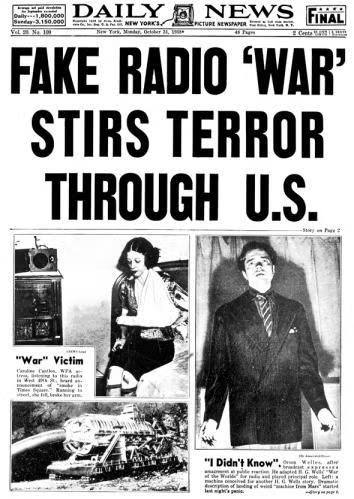All Hallows Eve, 1938. The world was about to experience an invasion. In a small studio, a young, up-and-coming actor named Orson Welles was about to unleash a wave of panic and hysteria with his radio adaptation of H.G. Wells’ classic science fiction novel, “The War of the Worlds.” This legendary Halloween broadcast has become a defining moment in media history, capturing the imaginations of listeners, sparking controversy, and reshaping the world of radio forever.

Orson Welles & the Mercury Theatre
The Mercury Theatre on the Air was no stranger to groundbreaking adaptations of classic literature. Led by the prodigious Orson Welles, the theatre company sought to push the boundaries of radio drama. Previous works received critical acclaim, but none achieved the level of fame “The War of the Worlds” attained.

A Masterpiece of Misdirection: The War of the Worlds Radio Broadcast Was Delivered As An Unfolding News Story

Welles and his team embarked on a bold experiment. They took H.G. Wells’ novel, set it in a contemporary American context, and presented it as a series of news bulletins interrupting a normal radio program. This format, along with the absence of disclaimers at the start of the broadcast, played a pivotal role in deceiving the audience. Welles himself played the role of the calm, collected news announcer, describing the Martian invasion as if it were happening in real-time.
Panic and Hysteria: Wells Broke The Airwaves

As the broadcast unfolded, a sense of realism and immediacy gripped listeners. Panic spread like wildfire. People believed that Earth was genuinely under attack by Martians. Phone lines were jammed with concerned callers, and some even fled their homes in a desperate attempt to escape the fictional threat. Newspapers the next day carried headlines of mass hysteria and “The Night America Panicked.”

Controversy and Fallout:
The aftermath of the broadcast was a whirlwind of controversy. Orson Welles and the Mercury Theatre were criticized for causing unnecessary panic. Welles, in turn, defended the broadcast, asserting that they had clearly stated it was a work of fiction. The event sparked debates about media responsibility and the power of the medium.

Legacy and Influence:
“The War of the Worlds” broadcast left an indelible mark on the world of radio, demonstrating its ability to create immersive, shared experiences. It forever changed the landscape of media, paving the way for a more regulated and responsible approach to radio broadcasts. It also cemented Orson Welles’ reputation as a brilliant innovator.

“The War of the Worlds” Radio Broadcast Modern Reimagining

In the years that followed, “The War of the Worlds” continued to be a source of inspiration. It has been adapted into films, television shows, and other media, each reimagining the Martian invasion in new and inventive ways.
The story’s enduring appeal lies in its ability to tap into primal fears of the unknown.

Now, eighty-five years have passed since the iconic Halloween broadcast aired. “The War of the Worlds” remains a testament to the power of radio and storytelling, a reminder of how imagination can blur the lines between fiction and reality. As we revisit this remarkable chapter in media history, we’re reminded that storytelling has the power to captivate, terrify, and provoke reflection, all with the flick of a radio dial.
Visit the Archives & Listen Now: Orson Welles “War of the Worlds” 1938 Broadcast





